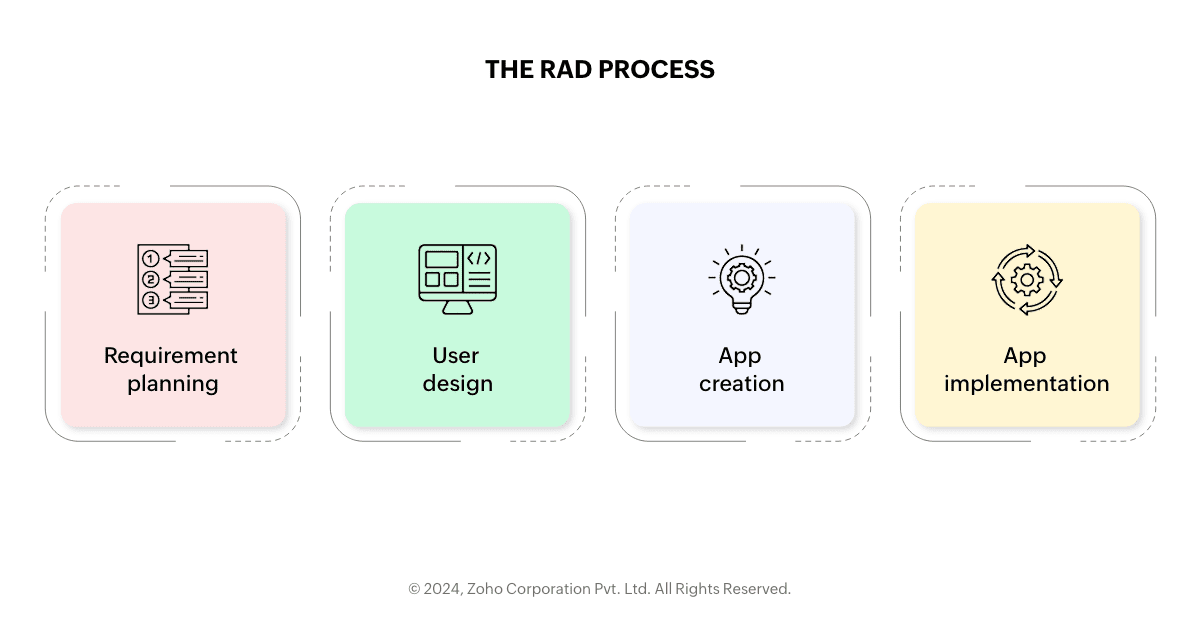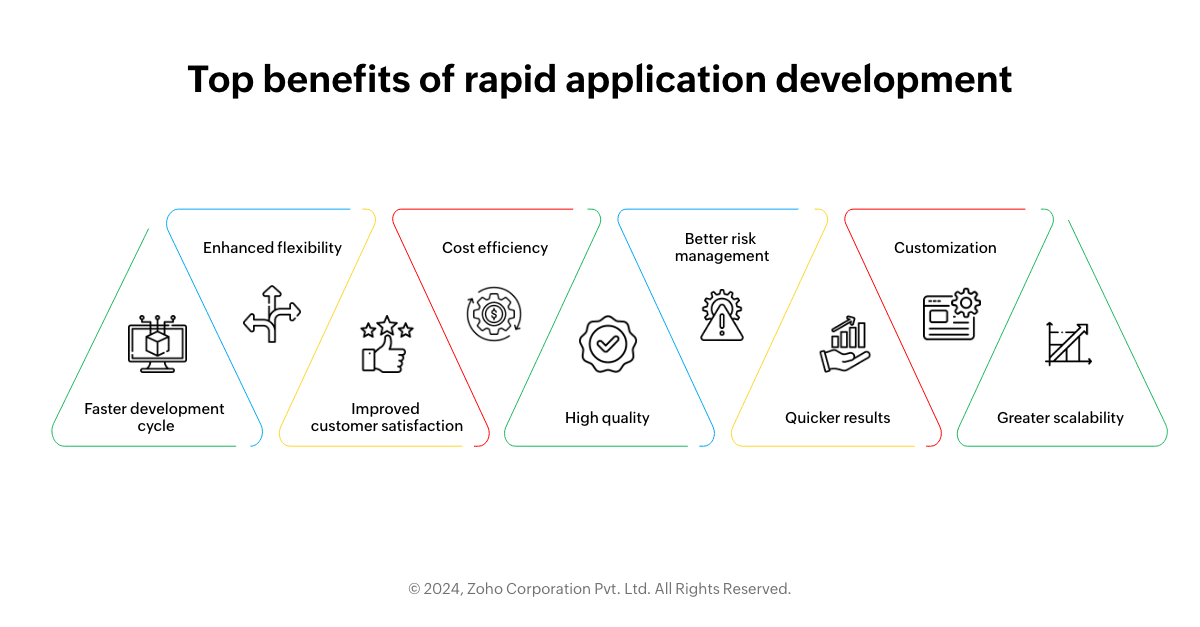- HOME
- Know Your Tech
- 9 benefits of rapid application development (RAD)
9 benefits of rapid application development (RAD)
- Last Updated : August 15, 2024
- 1.8K Views
- 5 Min Read
Is RAD really worth your time?
In today's fast-paced digital world, the ability to quickly develop and deploy software products is a crucial asset for any business. The conventional route that many take in developing software often falls short of meeting the increasing demands for speed and flexibility. If you are here, it could perhaps be for one of two reasons. Don't worry, you are in the right place!
This is where rapid application development (RAD) comes into play, offering a promising alternative. The benefits of RAD are numerous, ranging from shorter development cycles to enhanced flexibility, making it an attractive choice for businesses aiming to stay ahead in the competitive digital landscape.
What is rapid application development (RAD)?
Rapid application development is an intuitive application development process that emphasises rapid prototyping and iterative delivery. Unlike traditional software development methodology that are linear and rigid, the RAD model enables development teams to make quick adjustments based on user feedback, ensuring that the final product closely aligns with customer needs.
Rapid application development process
The rapid application development process is a form of agile methodology that emphasizes rapid prototyping and iterative cycles, with a focus on enabling businesses to develop software products rapidly and efficiently. The RAD model accommodates changes and end-user feedback more flexibly in the development process to ensure the final product closely aligns with their expectations. This is achieved through a series of phases that encourage rapid iteration, frequent user feedback, and continuous improvement.
Requirement planning
This stage is crucial for setting the scope of the project, but unlike traditional coding, it is not set in stone. The requirements planning phase is more about understanding the goals rather than detailing every specification. This allows for greater flexibility as the project progresses.
User design
This stage plays a pivotal role in the RAD model, allowing developers to quickly create prototypes of different modules of the application, which are then reviewed by the customer. This iterative process ensures that customer feedback is incorporated into the design early on, helping to align the final product with user expectations.

Creation
In this stage of the RAD model, the actual app development takes place. This stage employs various tools and techniques, such as computer-aided software engineering (CASE) tools, No-code Low-code app development tools, and automated testing tools to expedite the development process.
Implementation
In this stage of the RAD model, the developed application is moved into the production environment. This phase includes final testing, end-user training, and the official launch of the software. This stage also focuses on ensuring that the transition to the new system is as smooth as possible and that any issues are addressed promptly to minimize impact on the business operations.
By following these four stages, RAD model ensures quick prototyping, continuous client feedback, and iterative development process.
Does rapid application development really benefit you?
Without a doubt! The RAD methodology involves a less formal structure compared to traditional software development methods. The goal of RAD is to allow faster application development without compromising on quality.
For individuals like you or me, the RAD methodology democratizes software development, enabling us to quickly turn ideas into functional prototypes without extensive manual coding. With RAD's collaborative nature, the current development team can streamline project timelines and adapt to changing requirements.
Boosting business agility with RAD methodology
Rapid application development process enhances business agility by significantly reducing development time and allowing companies to adapt swiftly to changing market demands. RAD process enables businesses to modify their applications in real-time, ensuring that the software evolves along with their needs.
Core benefits of rapid application development (RAD)
1. Faster development cycle
As the name suggests, rapid application development significantly reduces the time it takes to develop applications through iterative process, prototyping and user testing. This approach allows for rapid development and delivers functional modules much quicker than traditional methods.
2. Enhanced flexibility
No need to fret over last minute changes requested by your business teams. The iterative nature of RAD allows changes to be made at any stage of the software development process. In the fast-paced environment, this flexibility fosters developers, users, and business analysts work closely together, sharing insights and feedback in real-time.
3. Improved customer satisfaction
By involving users throughout the app development process, RAD ensures that the final product is more closely aligned with user needs and expectations. This direct involvement is crucial for identifying potential issues early and refining the product to better suit customer requirements, leading to higher satisfaction.
4. Cost efficiency
The RAD model is considered one of the most lucrative methodologies in the application development industry for obvious reasons like, quick application development cycles, reusable components, and easy to maintain. Its also emphasis on early issue detection through continuous feedback and iterative testing prevents costly late-stage fixes.

5. Zero compromise
RAD serves as an example that lower costs don't mean lower quality in software development. By combining high quality with affordable methodology, RAD proves it's possible to be fast, cheap, and excellent all at once.
6. Risk management
By swiftly adjusting to changes and conducting regular testing, RAD offers enhanced risk management solutions that minimize the impact of issues and ensure the project remains on track, thereby reducing overall risk.
7. Competitive advantage
The RAD process helps businesses launch new products quickly, respond to customer needs faster, and update products based on real usage. This keeps businesses a step ahead of their competitors.
8. Customization
RAD's flexible framework supports high levels of customization, allowing products to be tailored to specific requirements with ease. This capability to customize extensively means products can more accurately meet the unique needs of each customer, further distinguishing a company's offerings from competitors.
9. Greater scalability
RAD’s intuitive design makes it easier to scale applications up or down based on business needs. This adaptability ensures that businesses can respond to growth opportunities or changing market conditions without starting from scratch, supporting long-term sustainability and evolution.
How to leverage benefits of RAD to the maximum?
The successful implementation of the rapid application development (RAD) process depends not only on establishing clear project requirements and maintaining consistent feedback channels but also significantly on the choice of the development platform. Low-code No-code platforms has emerged as the forefront of this, serving as a key enabler for RAD methodologies by significantly simplifying the app development process.
These platforms empower both developers and non-technical users to create applications using visual development interfaces that minimize manual coding. This facilitates faster iterations, accelerates application delivery, and cuts development time substantially. Thus, low-code platforms play a crucial role in making application development more accessible, perfectly aligning with RAD's objectives of swift deployment and continuous enhancement.
Click below to delve into the world of rapid application development.
 Aravind Jagannathan
Aravind JagannathanAravind Jagannathan is a product marketer at Zoho Creator and he currently focuses on video marketing. He is a passionate go-to marketer who loves to experiment with new things. Aravind is a travel photographer and an avid reader.



